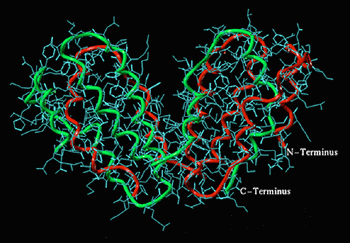Interferon-gamma (IFN-gamma) has multiple biological effects which have an influence on the human immune system. Based on these effects several therapeutic approaches were made. Recombinant IFN-gamma is synthesized in bacterial cells (E.coli). Although the bacteria are not able to synthesize glycosylated interferons this obviously has no effects on the biological activity. Unglycosylated Interferon-gamma is a highly basic protein. In comparison to the type 1 interferons (IFN-alpha and IFN-beta) it is less pH-stable and much less thermostable (melting point Tm 52 °C).
Interferon-gamma variant with increased biological activity

Aim of the project was to alter the amino acid sequence of IFN-gamma by specific modification of the gene and thus to obtain IFN-gamma variants of enhanced stability and enhanced biological activity, respectively.
Technology
At the beginning of our experiments the three-dimensional structure of human Interferon-gamma was still unknown. Therefore, protein design focused on the ends of the protein in order to avoid the generation of antigenic structures. These so called "second generation" proteins of IFN-gamma were designed by systematical truncation and modification of both the amino- and carboxy-terminal ends of the molecule.
Results
We found that IFN-gamma contains a protease-sensitive cleavage site near its carboxy terminus. This gave a hint to focus on the C-terminal truncation and modification of amino acids. All variants constructed were synthesized, purified and characterized with respect to biochemical, biophysical, and biochemical properties as well as biological activity. A carboxy-terminal truncation and modification of amino acids lead to a potent IFN-gamma variant HA (high acitivity) with an increased melting point. This variant was more active than the wild type protein in all biological assays tested, while its receptor affinity was slightly reduced. The results of this project were awarded with the Fraunhofer research prize for Prof. Dr. Bernd Otto.
Patents
A European patent is granted for this IFN-gamma-HA variant.
 Fraunhofer Institute for Interfacial Engineering and Biotechnology IGB
Fraunhofer Institute for Interfacial Engineering and Biotechnology IGB